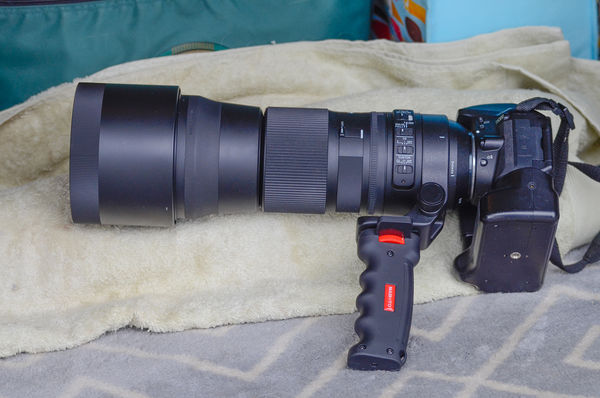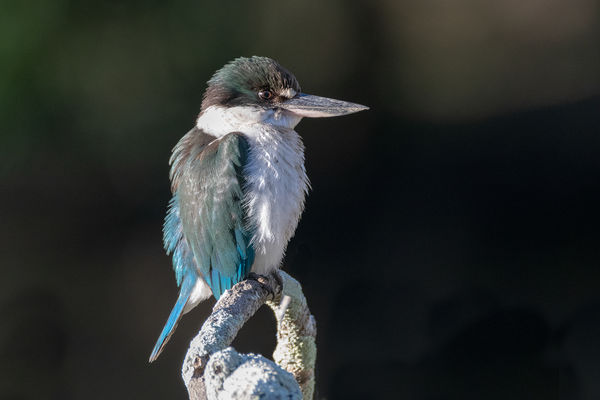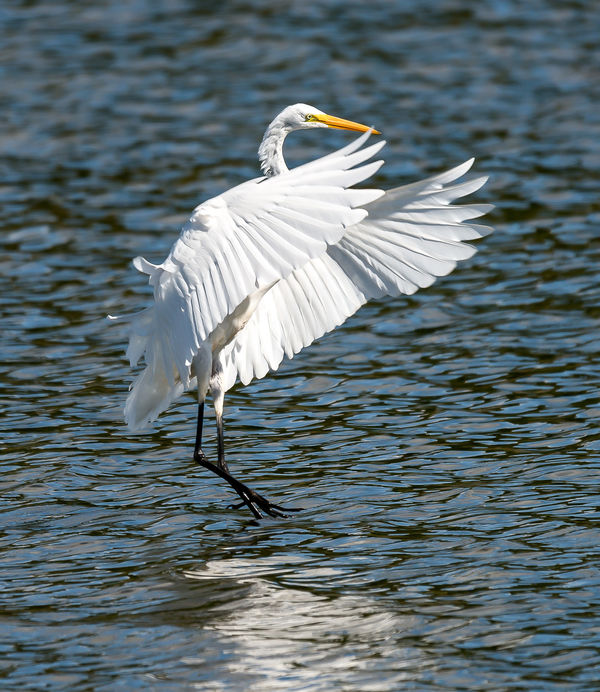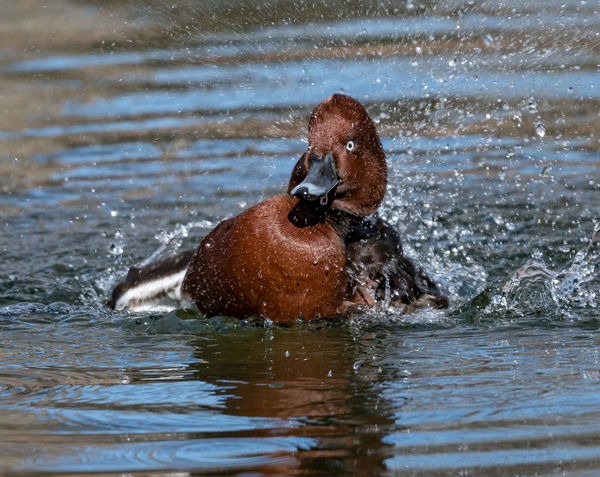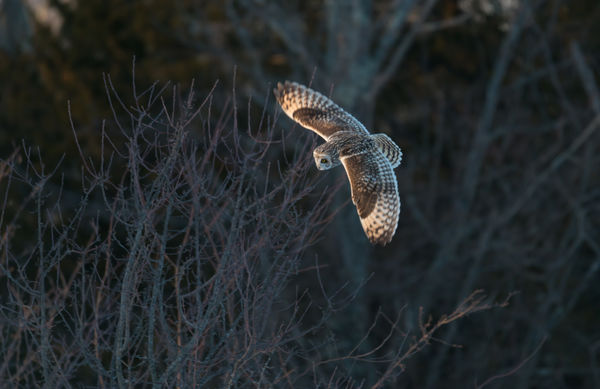Telephoto equipment and practises.
Sep 3, 2018 19:03:13 #
In the course of my travel assignment I do a lot of wildlife photography which entails a lot of telephoto work. I meet many photographers and inevitably the discussion turns to equipment and practices.
Some people would never go without a tripod (some swear by gimbals, others by pan and tilt heads and others by ball heads) while others would always go hand-held and some with a monopod.
Add to that full-frame versus APS-C, BBF, exposure and focus modes and there is always plenty to discuss.
IâÂÂd like to throw this discussion open to UHHers with my preferences as a starting point!
For wildlife photography I invariably use Nikon DX camera with FX lenses. My lenses of choice are Nikkor 70-300 IF ED VR etc and the Sigma 150-600 Contemporary. (weight and cost of the Sport version are determining factors).
If I am going to be in a single position for a good while (nest or watering hole) then I use a gimbal tripod. If I am doing a walk-through with some low-light situations I will use a monopod. For a quick, open-air walkabout I will hand hold.
I always use a pistol grip on the lens mount as, for me, it is much more stable and comfortable.
Few of my photographs are printed larger than 18 x 12inches (A3).
Settings: I always shoot raw+jpeg but for most assignments jpegs are acceptable. Raw is saved for anything that needs special treatment.
I use Auto ISO with a regular setting at 800 and a maximum ISO of 3200; minimum shutter speed of 1/500 when handheld.
Exposure: Centre weighted. Focus mode: AF-C with centre cluster selected: Manual override always on. I use back-button focussing.
I have enclosed photo of pistol grip and lens combo as well as a recent kingfisher photo.
Over to you!!!
Some people would never go without a tripod (some swear by gimbals, others by pan and tilt heads and others by ball heads) while others would always go hand-held and some with a monopod.
Add to that full-frame versus APS-C, BBF, exposure and focus modes and there is always plenty to discuss.
IâÂÂd like to throw this discussion open to UHHers with my preferences as a starting point!
For wildlife photography I invariably use Nikon DX camera with FX lenses. My lenses of choice are Nikkor 70-300 IF ED VR etc and the Sigma 150-600 Contemporary. (weight and cost of the Sport version are determining factors).
If I am going to be in a single position for a good while (nest or watering hole) then I use a gimbal tripod. If I am doing a walk-through with some low-light situations I will use a monopod. For a quick, open-air walkabout I will hand hold.
I always use a pistol grip on the lens mount as, for me, it is much more stable and comfortable.
Few of my photographs are printed larger than 18 x 12inches (A3).
Settings: I always shoot raw+jpeg but for most assignments jpegs are acceptable. Raw is saved for anything that needs special treatment.
I use Auto ISO with a regular setting at 800 and a maximum ISO of 3200; minimum shutter speed of 1/500 when handheld.
Exposure: Centre weighted. Focus mode: AF-C with centre cluster selected: Manual override always on. I use back-button focussing.
I have enclosed photo of pistol grip and lens combo as well as a recent kingfisher photo.
Over to you!!!

Sep 3, 2018 20:22:51 #
Alsweet wrote:
In the course of my travel assignment I do a lot o... (show quote)
Beautiful light on the Kingfisher.
I used to carry a tripod, gimbal and a 600mm F4. Now I go out with a Sigma Sport 150-600 and a D800 or D810. ISO 1000, F7.1 or F8 for depth of field, and a rifleman's stance with left shoulder oriented towards the subject. I will hand hold from 1/25 sec to whatever I need to freeze motion. Optical stabilization on at speeds slower than 1/500. I am constantly adjusting focus manually, when AF isn't getting the job done.
I print and sell some of my work. These will easily print up to 24x36 or larger.
Sep 3, 2018 20:55:11 #
Alsweet wrote:
In the course of my travel assignment I do a lot o... (show quote)
I like the idea of your post - but you have opened a BIG can of worms here ! - and I see you are fairly new here...
I will try to be very succinct - as always. I mostly do things very differently from most others. I am not a fanboy for anything accept finding the best solutions for my endeavors - that I CAN afford. I am on small budgets.
Birds are my main interest. I am a long time Canon shooter and I stay that way for birds - mostly in flight - because of the superior AF performance of Canon equipment. 3 years ago I went with Sony A77II also for wildlife - other than BIF's - mostly for the EVF, Clear Image Zoom, (CIZ) and all the other great in camera JPEG functions. CIZ has been a game changer for me !
I have developed some of my own unique stabilization equipment and techniques some of which can be seen here - https://www.uglyhedgehog.com/t-236741-1.html -
- https://www.uglyhedgehog.com/t-269999-1.html
Practices - hand held 99% for BIF only. Bodypod - for speed of mobility for 85% of subjects OTHER than BIF. Monopod - for 10% of subjects- very application specific. And tripod - 5% of subjects - where mobility is NOT a factor. I like following action with video/fluid pan tilt heads. I shoot JPEG only with minimal PP - but I do PP EVERYTHING. I do not use BBF, but I do use BB focus lock.
Please see my Fine Art America link below
..
My holding bracket for the Canon 400 prime
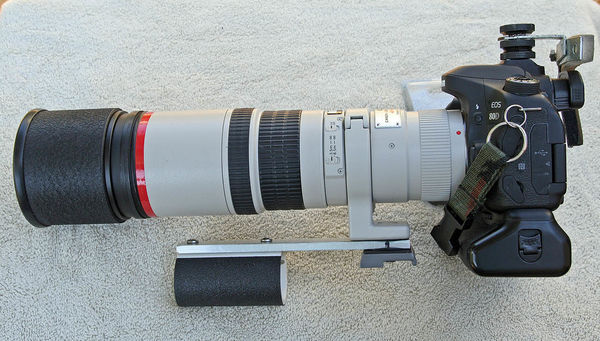
(Download)
One of my 3 monopods - ALL adjust from the TOP
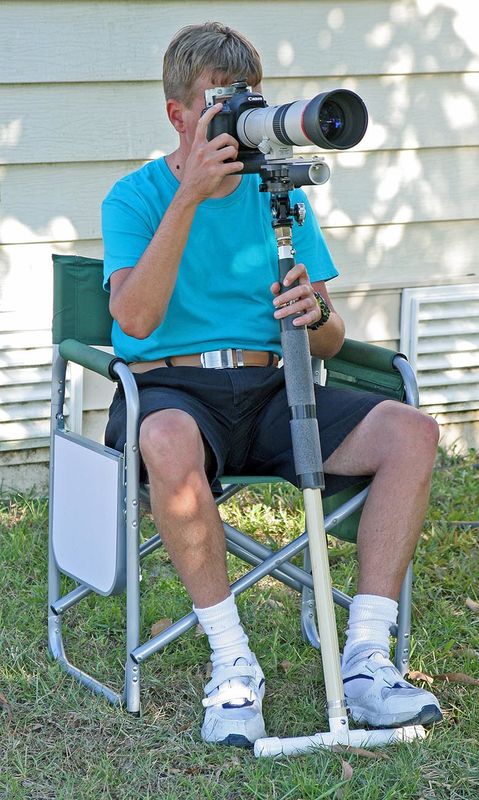
(Download)
My latest "Minipod" for smaller/light weight cameras/lenses
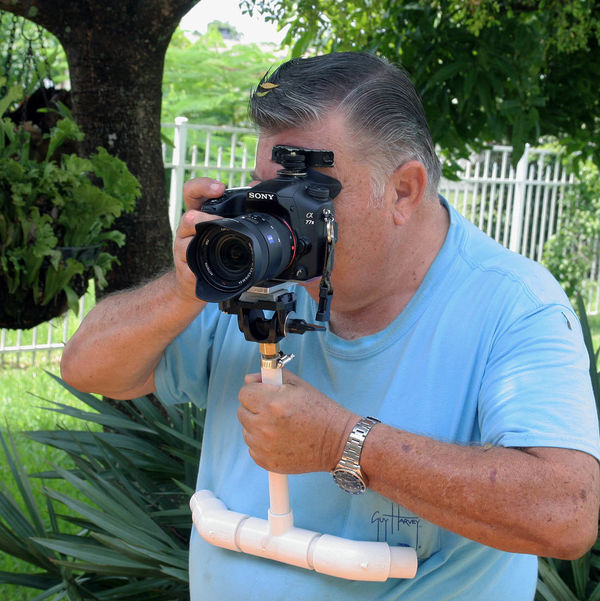
(Download)
Sep 4, 2018 07:19:38 #
Sep 4, 2018 07:29:01 #
catchlight..
Loc: Wisconsin USA- Halden Norway
Interesting and nice results for what you do ... on the other end of the spectrum I would like to comment.
I use a Canon 200 200 f/2.0L and 300 F 2/8L prime daily and often shoot 125 or even as low as 80/ sec with iso 100- 200 for panning automotive if it is sunny with f/stop around 2.0 to 4.0 depending on depth. Still images iso 100 is perfect and a tripod extends shoot time to dusk. If I need an interior or engine shot I may go to iso 400 without flash with a 70-200 F 2/8L.
The Canon 200 f/2.0 is capable of sharp images at 5 f stops hand held under the focal length because of the stabilizer system, so that means unless you are stopping action. that lens handheld is sharp at 1/5 sec.
Spin blur, motion blur and many other factors come into choosing the f stop, iso and shutter speed for me.
I use a Canon 200 200 f/2.0L and 300 F 2/8L prime daily and often shoot 125 or even as low as 80/ sec with iso 100- 200 for panning automotive if it is sunny with f/stop around 2.0 to 4.0 depending on depth. Still images iso 100 is perfect and a tripod extends shoot time to dusk. If I need an interior or engine shot I may go to iso 400 without flash with a 70-200 F 2/8L.
The Canon 200 f/2.0 is capable of sharp images at 5 f stops hand held under the focal length because of the stabilizer system, so that means unless you are stopping action. that lens handheld is sharp at 1/5 sec.
Spin blur, motion blur and many other factors come into choosing the f stop, iso and shutter speed for me.
Sep 6, 2018 15:54:25 #
amfoto1
Loc: San Jose, Calif. USA
I use a bunch of different telephotos...
85mm f/1.8
135mm f/2
Two 70-200mm (one f/2.8 and the other a smaller, lighter f/4)
Three 300mm (one f/2.8, two f/4)
100-400mm
500mm f/4
100mm f/2.8 macro
180mm f/3.5 macro
I also use 1.4X a lot with many of those lenses... and, less often, a 2X teleconverter (mostly only on the 300/2.8 and 500/4.... 2X "cost" a lot of image quality and work best with very high quality primes, IMO.
The vast majority of the time, I use telephotos on crop sensor cameras. This "leverages" the longer focal lengths, making them "act" even more powerful. Or, another way of looking at it, lets me to use smaller, lighter lenses that allow me to be be more mobile.
I try to shoot handheld as much as possible, but use monopods and tripods as necessary.
I have two monopods.... one with a ballhead, the other without. The only reason I use a ballhead instead of a monopod head is because I already had the ballhead from an old, broken tripod.
I have three tripods.... two of which I primarily use with telephotos. One is fitted with a heavy duty ballhead and has a gimbal adapter. The other has a full size gimbal head that makes it more "large lens only". The third tripod is set up with another heavy duty ballhead, can serve as a backup, but is mostly intended for macro work (has a reversible center column for very low angle work, plus extends extra tall for overhead shooting). All three tripods are carbon fiber Gitzo Series 3 Systematics which are quite stable and easy to customize for various uses. But they aren't particularly small or lightweight. (Though they are about half the weight of a big old metal tripod I now use in studio only. I am not traveling much other than by car these days... If I were I might invest in another, more compact and portable tripod for air travel, etc.... Or just take a monopod instead.)
The 85, 135, 70-200s and 300/4s I use mostly handheld. The 100-400mm I use a lot handheld, too, but also put it on a tripod or monopod fairly often during longer shooting sessions (it weighs about 3.5 lb.). The 300/2.8 and 500/4 I use on tripods or at least a monopod almost always.... only very rarely use them handheld. They're fairly heavy (around 6 lb. and 8 lb. respectively). The macro lenses I usually use only for macro work, and that's usually on a tripod or at least a monopod.
I also carry a beanbag in my car, to rest a lens on a windowsill or hood or fence post, rock or tree limb for a shot.
To transport large lenses I have two Lowepro backpacks.... as smaller one that accommodates up to the 300mm f/2.8 along with various other lenses and a camera and a larger one hat accommodates up to the 500mm. But at a lot of events the backpacks stay in my car and I use a small shoulder bag with 2 or 3 shorter lenses (and other miscellany) and mount a 70-200 and 300mm or the 100-400 on a couple cameras that are carried by their straps. The 100-400 is an f/4.5-5.6 lens, so mostly gets used in "good light"... in lower light conditions I switch to the f/4 lenses... or in the most challenging, the f/2.8 and faster lenses.
I also have OpTech Rain Sleeves and cheap plastic ponchos in my camera bags, backpack and car, just in case I'm caught out in nasty weather. (Contrary to popular belief and tourism ads, it's not always sunny in Calif.!)
With the exception of the 85 and 135mm, all my telephotos are image stabilized. I LOVE IT (it's the best thing since sliced bread!) and use it 99% of the time, regardless of shutter speed. The effectiveness of the IS varies, depending upon the age/generation of the lens. The older ones' IS is good for 2 to 3 stops worth of assistance (all three of my 300mm lenses, 70-200/2.8 and 500mm).... The newer generation models are good for 3 to 4 stops help (70-200/4 and 100-400). I see some of the very latest lenses are now claiming their IS offers as much as 4 to 5 stops assistance. But of course with them all this varies a bit depending upon the user and the exact situation. Good, careful technique and practice are still important. IS doesn't guarantee a sharp, shake free shot... simply increases the odds of getting more good shots. And, no matter how good it might be, stabilization can't do a thing about subject movement blur.... That still requires and adequate shutter speed if one wants to completely freeze movement.
85mm f/1.8
135mm f/2
Two 70-200mm (one f/2.8 and the other a smaller, lighter f/4)
Three 300mm (one f/2.8, two f/4)
100-400mm
500mm f/4
100mm f/2.8 macro
180mm f/3.5 macro
I also use 1.4X a lot with many of those lenses... and, less often, a 2X teleconverter (mostly only on the 300/2.8 and 500/4.... 2X "cost" a lot of image quality and work best with very high quality primes, IMO.
The vast majority of the time, I use telephotos on crop sensor cameras. This "leverages" the longer focal lengths, making them "act" even more powerful. Or, another way of looking at it, lets me to use smaller, lighter lenses that allow me to be be more mobile.
I try to shoot handheld as much as possible, but use monopods and tripods as necessary.
I have two monopods.... one with a ballhead, the other without. The only reason I use a ballhead instead of a monopod head is because I already had the ballhead from an old, broken tripod.
I have three tripods.... two of which I primarily use with telephotos. One is fitted with a heavy duty ballhead and has a gimbal adapter. The other has a full size gimbal head that makes it more "large lens only". The third tripod is set up with another heavy duty ballhead, can serve as a backup, but is mostly intended for macro work (has a reversible center column for very low angle work, plus extends extra tall for overhead shooting). All three tripods are carbon fiber Gitzo Series 3 Systematics which are quite stable and easy to customize for various uses. But they aren't particularly small or lightweight. (Though they are about half the weight of a big old metal tripod I now use in studio only. I am not traveling much other than by car these days... If I were I might invest in another, more compact and portable tripod for air travel, etc.... Or just take a monopod instead.)
The 85, 135, 70-200s and 300/4s I use mostly handheld. The 100-400mm I use a lot handheld, too, but also put it on a tripod or monopod fairly often during longer shooting sessions (it weighs about 3.5 lb.). The 300/2.8 and 500/4 I use on tripods or at least a monopod almost always.... only very rarely use them handheld. They're fairly heavy (around 6 lb. and 8 lb. respectively). The macro lenses I usually use only for macro work, and that's usually on a tripod or at least a monopod.
I also carry a beanbag in my car, to rest a lens on a windowsill or hood or fence post, rock or tree limb for a shot.
To transport large lenses I have two Lowepro backpacks.... as smaller one that accommodates up to the 300mm f/2.8 along with various other lenses and a camera and a larger one hat accommodates up to the 500mm. But at a lot of events the backpacks stay in my car and I use a small shoulder bag with 2 or 3 shorter lenses (and other miscellany) and mount a 70-200 and 300mm or the 100-400 on a couple cameras that are carried by their straps. The 100-400 is an f/4.5-5.6 lens, so mostly gets used in "good light"... in lower light conditions I switch to the f/4 lenses... or in the most challenging, the f/2.8 and faster lenses.
I also have OpTech Rain Sleeves and cheap plastic ponchos in my camera bags, backpack and car, just in case I'm caught out in nasty weather. (Contrary to popular belief and tourism ads, it's not always sunny in Calif.!)
With the exception of the 85 and 135mm, all my telephotos are image stabilized. I LOVE IT (it's the best thing since sliced bread!) and use it 99% of the time, regardless of shutter speed. The effectiveness of the IS varies, depending upon the age/generation of the lens. The older ones' IS is good for 2 to 3 stops worth of assistance (all three of my 300mm lenses, 70-200/2.8 and 500mm).... The newer generation models are good for 3 to 4 stops help (70-200/4 and 100-400). I see some of the very latest lenses are now claiming their IS offers as much as 4 to 5 stops assistance. But of course with them all this varies a bit depending upon the user and the exact situation. Good, careful technique and practice are still important. IS doesn't guarantee a sharp, shake free shot... simply increases the odds of getting more good shots. And, no matter how good it might be, stabilization can't do a thing about subject movement blur.... That still requires and adequate shutter speed if one wants to completely freeze movement.
Sep 6, 2018 23:43:11 #
I started this discussion hoping to hear what others are doing. I am not disappointed! I'm amazed at the ways people approach their photography and often improvise when necessary.
Please, keep up the good work, enjoy what you are doing. I'd like to keep this topic open as there are many others out there with, I'm sure, many different ideas and techniques that we'd love to hear about.
Please, keep up the good work, enjoy what you are doing. I'd like to keep this topic open as there are many others out there with, I'm sure, many different ideas and techniques that we'd love to hear about.
Sep 7, 2018 00:54:40 #
Alsweet wrote:
I started this discussion hoping to hear what others are doing. I am not disappointed! I'm amazed at the ways people approach their photography and often improvise when necessary.
Please, keep up the good work, enjoy what you are doing. I'd like to keep this topic open as there are many others out there with, I'm sure, many different ideas and techniques that we'd love to hear about.
Please, keep up the good work, enjoy what you are doing. I'd like to keep this topic open as there are many others out there with, I'm sure, many different ideas and techniques that we'd love to hear about.
I followed the thread now I guess it is time to chime in.
In the past I have used a 70-300 zoom and then a Tamron 150-600 the G en 1, then I added a Canon 100-400L mk 1 and later traded for a mk 2. When hand holding I use a pistol grip on the tripod mount. On a tripod I use a gimbal head although I also have an older 3 way video head. I have used it on a monopod but found the regular ball heads unsatisfactory so I got a pistol grip ball head. This mono plus pistol grip ball head is reserved for times I cannot use a tripod as it is my least favorite method of using a tele. I often use the 100-400 mk 2 (and the mk 1 when I had it) with a 1.4x III. I often also have a Red Dot sight on the camera's hot shoe so I can use both eyes to find and follow moving subjects like BIF and aircraft. I even have hot shoe splitters that allow me to use the Red Dot and a flash at the same time. A bit awkward but with practice I have made the combo work. Since I work with two bodies I find I miss having two long lenses and am considering getting the Tamron Gen 2.
For working fairly close, like hummers and others around a feeder, esp from a blind I sometimes add a Kenko Pro 300 1.4x to my Tamron 180 macro and put it on my APS-C body for a total angle of view eq. to 403 mm. I have a Kenko Pro 300 2x also but the IQ wasn't as good as with the 1.4x, that was with a 7DII, I haven't tried it with my 80D, I should, the results may be better.* I should also try both with my 5DIV the 180 + 1.4x worked well with a 6D but I have never tried it with my 5DIV.
* Different combos just seem to work better than others for some reason. Like the 100-400L mk1 does not play well with filters, any filters no matter how high quality.
If you want to reply, then register here. Registration is free and your account is created instantly, so you can post right away.

